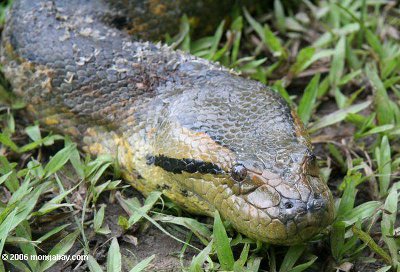Green Acnaconda Snake
Category: Snakes

Facts about Green Anaconda snake. "Scientific name for Green Anaconda snake is Eunectes murinus and it is a Eunectes type of nontoxic snake that comes from the Boidae family. The Green Anaconda snakes are native to South America and they are the biggest, heaviest, and the second longest recognized existing snake varieties. The Green Anaconda snake are called by other names, such as water boa and common anaconda. Similar to other snakes and nearly all other reptiles, the Green Anaconda snake can fairly effortlessly adapt to a change in the type of weather, atmosphere and near surrounding when required. The Green Anaconda snake are largely found in South America in the eastern parts of the Andes, in neighboring countries, including Venezuela, Colombia, the Guiana, Peru, Ecuador, Bolivia, the island of Trinidad, Brazil, and as far as the northern parts of Paraguay. The Green Anaconda snake live in marshes, swamps, and slow-moving watercourses, mostly in the tropical forests of the Orinoco and Amazon River basins.
Features of Green Anaconda snake
The Green Anaconda is the heaviest and one among the longest snakes in the world, with a male snake attains a minimum body length of 22 feet (6.70 meters) when matured, whereas the female anaconda attains a minimum body length of 15 feet (4.57 meters). The Green Anaconda snake varieties have a body mass, ranging from 66 pounds to 154 pounds (30 to 70 kg). They are the largest native snake of the Americas.
The color pattern of the Green Anaconda is made up of the olive green backdrop overlaid with black color blotches down the length of their body. The head of the Green Anaconda snake is narrow when compared to its body, typically with unique orange-yellow lines on both sides of their body. The eyes of the Green Anaconda snakes are set high on their head, enabling them to witness out of the water during swimming devoid of revealing their body.
Diet of Green Anaconda snake
The Green Anaconda is chiefly an aquatic snake variety, and feed mostly on an extensive variety of prey, virtually anything they can handle to overpower, including birds, fish, a diversity of animals, and other reptiles. Particularly, big anacondas may even feed on prey such as deer, tapirs, caimans and capybaras, but such huge meals are not regularly eaten.
Behavior of Green Anaconda snake
The Green Anaconda is chiefly a nocturnal snake variety that is inclined to spend the major part of its life in or about water. The Green Anaconda snakes are also occasionally recognized as the water boa and they spend additional time in water when compared to the boas. The Green Anaconda seems rather sluggish and lethargic while traveling on land because of their body size, even though they have the prospective to attain high velocities in water. The Green Anaconda snake are inclined to float under the water surface through their nose over the surface. When prey crosses or stops to drink the water, the snake will hit, without consuming or ingesting it and coil around the prey by means of its body. The anaconda will afterward constrict, pending it has productively suffocated the victim.
Reproduction of Green Anaconda snake
The Green Anaconda is lonely until the mating period, which takes place during the raining season, and can continue for a number of months, generally from April to May. During the mating season, male anacondas have to locate female anacondas for mating. Usually, female Green Anaconda snakes will lay down a track of pheromones for the males to follow. The female snakes remain stationary while several male anacondas will move towards the female Green Anaconda snake from all directions. Male snakes also often brush their tongue to detect chemicals that indicate the existence of the female anaconda. Usually, male anacondas use their spurs to stimulate the female during mating. They violently press their cloacae areas hard against the body of the female Green Anaconda snake, while incessantly scratching the female snake through their spurs. Generally, the gestation period takes 6 to 7 months. The oviparous female snake gives birth to 20 to 40 offspring.
The average lifespan of the Green Anaconda snake is 10 years in the wild, whereas in the captive, they can live up to 30 years.

 Back To Category Snakes
Back To Category Snakes